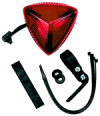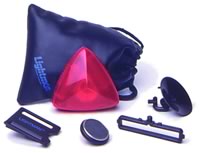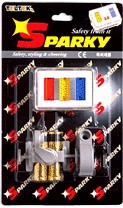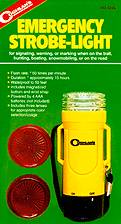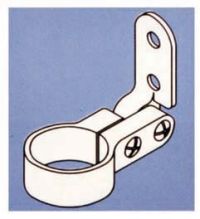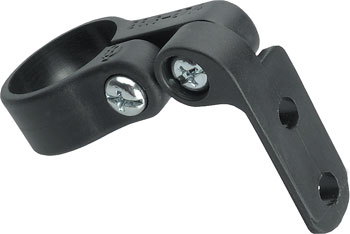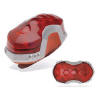Taillights
This Sub-Page of
http://bicyclelighting.com last
updated on 20 March 2008
One of the biggest problems with
commercial lighting systems is the inadequate tail lights. The best tail lights,
in terms of visibility, are xenon strobe
lights. These are finally being offered by Lightman, and are
also being resold by Night-Sun (in fact xenon strobe tail lights are the only
tail lights sold by Night-Sun). With a 12 volt system you can also use one of the many Xenon strobes
available for automobile use; these are much less expensive, typically under
$10. Xenon strobes are a far better choice than LED
blinkers. Xenon strobes are much more visible, especially in areas that have a
lot of ambient light. Xenon strobes are also very visible in the daytime, where
most LED blinkers are worthless. In low visibility conditions, such as rain or fog,
LED blinkers are useless, while xenon strobes will still be visible. Xenon
strobes are much less directional, with visibility over an 180 degree range,
while LED blinkers are limited to 50-60 degrees, except for a few with side
pointing LEDs. I've seen concerns voiced that
the xenon strobes are so bright that they annoy motorists, but in fifteen years
of using them I have never known this to be the case (these strobes are not as
bright as the strobes used on tow trucks or police cars).
So why are LED blinkers so popular if they are so
much worse than xenon strobes? Amusingly, one cyclist in rec.bicycles.misc
claimed that LED blinkers must be effective simply because so many people use
them. The fact is that they are popular because they are cheap and widely
available. Please don't fall for the "Everybody does it, so it must be
safe" fallacy.
If you choose to use an LED blinker,
go with one of the ones recommended below, the best choice is the Cateye LD1000. If you still choose to use a small LED blinker then also
use some large red reflectors. In Effective Cycling
(click to buy, but beware that some of the material is dated), John Forrester goes
so far as saying that if you have adequate reflectors then LED blinkers are
unnecessary. While in general Forrester's statement is true, there are cases
where an LED blinker is better than reflectors-only; i.e. if a vehicle doesn't
have its headlights on, a reflector doesn't work.
Note that flashing red lights (and
flashing blue lights) are not legal for
use on moving vehicles in many countries, and in most states in the U.S.. An LED
blinker is not bright enough for the police to bother you (in most cases), but a
red strobe may be a different story. If using a strobe, it is better to go with
an amber strobe, since in most places these are legal for use on slow-moving
vehicles.
There is an extensive U.K. study on
beacons, entitled: Motor vehicle conspicuity: - Warning
Beacons. It is very interesting to read the comparisons of detection
times based on color. Amber had the poorest detection time based on constant
intensity, but the best in real world because of the way strobes are
manufactured (amber strobes of are higher intensity given a specific lamp
intensity filtered by a colored dome because the amber domes transmit the most
light (other than clear domes)). They conclude that amber and red strobes,
together, offer the best compromise in detection and discomfort.
Xenon Strobe
The
taillight I use is a Velleman xenon strobe tail light available from All
Electronics (red, green, and blue also available); current draw is 1.8W.
There are other 12 volt Xenon strobes available, including one that is re-sold
by Nightsun. There are now several commercial xenon strobes
available, but you have to order them on-line as bicycle shops do not carry
them. Blue strobes may not be legal to use as they are often restricted to law
enforcement personnel. Red flashing lights are illegal for use on moving
vehicles in most places, and this includes bicycles. Amber is the best choice,
both for visibility and legality. Xenon strobes usually are sealed, with the bulbs
soldered onto the printed circuit board. Replacement bulbs are sold at Radio
Shack, but it's probably more trouble than it's worth for the Velleman strobe at
only $9.
The flash frequency of xenon strobes decreases as
the battery voltage falls. This is a problem on the AA powered xenon strobes.
You always want to have good batteries in the strobe. The 12 volt strobe is a
better option if you are running a 12 volt system.
A red taillight should always be used in
conjunction with an amber strobe. This keeps you legal, and provides additional
visibility. You can use an LED blinker, set to steady-on to be legal, but
flashing is better).
Note that xenon strobes use a lot
more power than LED flashers. The xenon strobes with internal batteries will run
only a couple of hours. High-capacity rechargeable batteries should be used for
xenon strobes that are heavily used, and carry some spare alkaline or lithium AA
cells as a back-up.
Click
Images for Details
Taillight
Mounting
Rear Rack
The Velleman strobe has two studs out the bottom and they include nuts and
lock washers. I simply used a piece of flexible steel (from a hose clamp) and
drilled two holes in it to match the studs (with a little extra length). I then
clamped the strobe onto the back of the rear rack (a Specialized Expedition
Rack). You could also use a short piece of steel banding from crates. Some rear
racks Tubus Cargo
Rack has a place to mount rear lights. You can also get a self-powered Xenon strobe. I don't think that
blue is legal for non-law enforcement personnel. Note that most states require a
red rear reflector but do not forbid the use of amber lights (which are more
visible than flashing red lights); do not remove your red reflector if you
choose an amber strobe. I find that amber strobes are better because to a
motorist they denote caution, while a red strobe blends in with other red tail
lights of cars. Check local laws.
You may want to consider using two xenon strobes,
one in the center and one extending out to the left side (or one on the left
side and one on the right side). Use a thin strip of wood to mount the strobes,
and then fasten the strip of wood to your rack. The wood should be thin so it
breaks if hit.
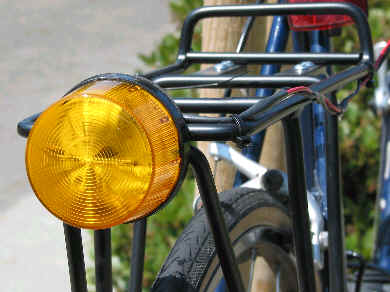 |
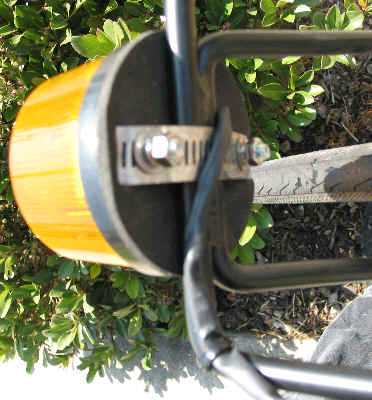 |
| Amber Strobe attached to Rear
Rack. Use a short strip of flexible steel with holes drilled to match the studs.
I had an old hose clamp that I grabbed. You can't use stiff aluminum bar because
the studs aren't long enough.
Use some Loctite on the nuts as well. Strain relief the thin wire that goes into
the strobe with a cable tie to the rack. Battery goes into a rack top bag
that I carry while commuting. |
Reflector Bracket
Rear reflector brackets that mount to the rear brake bolt are fine, even the
Dimension plastic one. This approach should only be used if you do not have a
rear rack, since the rack, even without luggage, will block the light.
Click
Images for Details
Seat Post or Seat
Mounting a strobe to the seat post can be accomplished with a seat post
bracket. Note the swivel so you can make the light straight even though the seat
post is slanted--be sure to adjust the bracket so the light is level. Measure the diameter of your seat post with a vernier caliper
and order the proper size bracket.
Click
Images for Details
Rear
Racks with Integral Reflector/Light Brackets
If you're buying a new rear rack you should try to buy one that has an
integral mount for a reflector/rear light. The steel racks are nice, but very
expensive.
Click
Images for Details
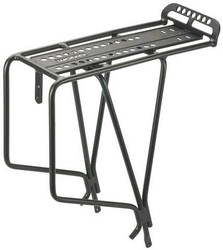 |
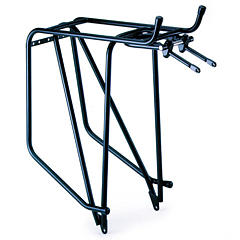 |
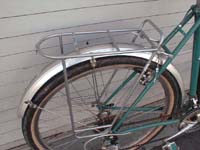 |
|
Axiom
Odyssee Tubular Alloy Rack with reflector/rear light bracket |
Tubus CroMo Steel Rack |
Nitto Steel Rear Rack |
|
$23 |
$100 |
$135 |
LED Blinkers
LED blinkers became popular because they
are cheap, widely available and because the batteries last a long time. LED
blinkers are often the only type of tail lights sold at bicycle shops, web
retailers, and hardware stores, which leads to their popularity. So since
everyone seems to use them this must mean that they are good, right? Well, no,
not really. Here is a list of some of the problems with LED blinkers.
-
They are not very bright.
They look great when it's really dark with no other light sources from vehicles,
street lights, etc., but in reality they do little to make a cyclist visible in
traffic.
-
They have a limited
visibility range (50-60 degrees) compared with 180 degrees for xenon strobes.
-
They are virtually worthless in rain, fog, or other low visibility
conditions.
-
The cheaper ones have no reflective material behind the red
lens; unfortunately you will be unable to determine this until you open the package and inspect
the unit.
-
They are usually not built
very well. They are not waterproof, the snap on lenses can pop off when you hit
a bump, and the mounting to the bicycle is usually by a cheap plastic clamp.
-
They are not visible in daylight
(a xenon strobe is visible even in the daytime).
-
They are small, and to a driver small means far away (note that this does not apply to the 4"x6" LED flashers)
-
They are red, which is a less visible
color, especially to
older drivers. Yellow is a better color for a flasher because it is more
visible to the eye.
-
They need to be carefully positioned in order to be visible.
This is due to their limited visibility range.
-
They do not emit enough light to
be useful at all on winding roads. With a xenon strobe, a motorist coming
around a curve will have an earlier warning.
-
In most states, flashing red lights are not permitted on
moving vehicles, but flashing amber lights are okay.
In areas where flashing lights are illegal, high brightness LEDs may be a viable
alternative to a strobe (in most of Europe, blinking lights are illegal and the
LEDs stay on all the time). 18 high brightness LEDs will draw 360 mA or so when
on all the time, and maybe 100 mA when flashing, a Xenon
strobe will draw 150mA max.
In short, I am very much in favor of
spending the money for xenon strobes because they are far more effective. Even
Night-Sun, the premier high performance bicycle light company, sells only xenon
strobes for tail lights.
Also read "http://www.gonecycling.com/commuter/commuting.html"
which states: "Certainly the most common type is the LED flashing rear light. Be aware that the devices are very directional. Unless a motorist is directly and level behind you, and you aimed it right, the effect is not much better than a reflector of the same
size... Reflectors work great at the back of the bicycle. I use a three inch amber reflector on the fender and it works great. I'm sure it is the first thing a motorist will see on a flat
level section. For illumination, I used a Xenon strobe. It is much less directional
than LED and brighter too. More expensive and the batteries last only two winter commutes."
There are (or were) some decent LED blinkers.
One is called
Real Lite, and it is available from Harris Cyclery. It is
quite costly at $40. If Sheldon Brown endorses it then
that's good enough for me! I received an e-mail from the importer of the Real
Lite that stated that the Real Lite uses high-brightness LEDs while the cheaper
18 LED blinkers do not. This is part of the reason for the disparity in price;
the high brightness LEDs are much more expensive. The Real Lite LEDs will have a
longer lifetime than a xenon strobe.
The Specialized Afterburner Comp has
a unique lens system that appears to somewhat solve the viewing angle
problem. Unfortunately it has been discontinued. The big complaint about this
light is the poor mounting bracket, so you'll have to figure out a way to mount
it.
Martin Kreig of the National
Bicycle Greenway, wrote: “I've been lusting for the perfect bike flasher since
the days of the trusty Belt Beacon.
The Trek webpage at
http://www.trekbikes.com/accessories/cat_browse.jsp?category_id=130 states
that Trek offers tail lights with up to 330 degrees of visibility, and up to
5000 feet. Trek has removed this light from their web page, so I thought they
have discontinued it, but according to a local Trek dealer in my area, it
actually is available: "TREK part# 69575, Disco Inferno flashing tail-light, presently available in
large qtys at both east & west-coast warehouses (midwest warehouse presently
out of stock). This light has not to my knowledge been discontinued and, in fact, has been recently revised. Price is about $25. Impressive light; I've
installed one on my rain bike."
Click
Images for Details
|
 |
 |
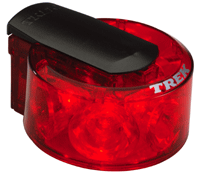 |
| Real Lite 18
LED Tail Light. Uses 4AA Batteries. |
Specialized
Afterburner Comp (discontinued) |
Trek Disco
Inferno (red version is discontinued, but a white version is still being
sold at bike shops) |
| $40 |
$20 |
$28 |
There are six other available good rear lights.
First there is the B&M 4DToplight
Senso, available in three different versions. The 4DT is not a flasher, but it
does offer the wide angle of visibility. One good thing about these B&M rear
lights is that they are available both in battery powered, and dynamo
powered/battery backed up, versions; this means that dynamo aficionados finally
have a decent rear lamp available. As far as I can tell, they are sold only by
Harris Cyclery (Sheldon Brown), though one version is sold by Peter White
Cycles.
Click over to:
http://sheldonbrown.com/harris/lighting/shimano.html and search for
"Taillights for rack mounting" and scroll down to the 4D series. There are three
versions available:
1. 4DToplight Senso, (battery powered, switches on by itself in the dark): $
26.95
2. 4DToplight Senso Multi, (generator or battery powered, switches on by itself
in the dark): $ 29.95
3. 4DToplight Permanent, (battery powered only, doesn't turn on by itself): $
21.95
At least in the U.S., the
4DT should be used in conjunction with a Real Lite 18 LED flasher, since a
flashing rear light has become the de-facto identifier of bicycles.
Second there is the Cat Eye LD1000
with six rear facing LEDs, and two sideways facing LEDs on each side. This is
battery powered (2 AA) only. Quite pricey at $30, but there is no real
competition. Click over to: http://www.nashbar.com/profile.cfm?category=101&subcategory=1068&brand=&sku=12860&storetype=&estoreid=&pagename=
Third, there is the Mega Bike Strobe
tail light. This one is similar to the Real Lite, above, but has 17 LEDs rather
than 18, with 15 LEDs pointed toward the rear, and two LEDs pointed to the side.
Not sure about the brightness of each individual LED.
Fourth, there is the newly
introduced Blackburn Mars 3.0 Rear Light with side LEDs. See it at
http://www.blackburndesign.com/lights.html. Buy it at
http://www.campmor.com/webapp/wcs/stores/servlet/ProductDisplay?partNumber=54722.
This is a good deal at only $13, not much more than a junky LED rear light.
Fifth and Sixth. aret the Trek Flare
10 and Trek Flare 7. The Flare 10 uses 10 LEDs and provides (according to the
manufacturer) 360 degrees of visibility using 2 AA batteries. The Trek Flare 7
uses 7 LEDs and provides (according to the manufacturer) 270 degrees of
visibility using 2 AAA batteries.
While it's great that there are some
decent rear LED lights available, xenon strobes remain the best option for a rear
light in a 12 volt system.
This is due to their much greater brightness, wide angle of visibility, and
significantly lower cost. However you do have the overhead of the separate
battery.
Return to http://bicyclelighting.com

